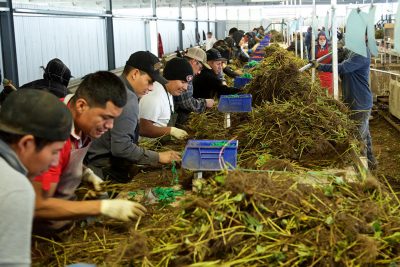A Preview: Major Property Rights Case Currently Before U.S. Supreme Court
Decision in Cedar Point Nursery Could Imperil Key Health, Safety & Environmental Programs

On Monday, the U.S. Supreme Court will hear oral arguments in a major property rights case from California: Cedar Point Nursery v. Hassid. That litigation arises in a labor law context. But, depending on how the Court rules, the case could have major, deleterious impacts on a wide array of health, safety and environmental programs.
Cedar Point involves an agricultural industry challenge to a longstanding regulation enacted by California’s Agricultural Labor Relations Board. This A.L.R.B.’s 1975 “Access Regulation” allows farmworker union organizers to access the grounds of agricultural growers for portions of up to 120 days/year to speak to farmworkers about whether or not to support the union. Under the regulation, union representatives must notify both the A.L.R.B. and the affected company in advance of their intent to visit the property.
Two California corporate growers sued in federal court to challenge the Access Regulation. They claim that by giving union organizers access to their agricultural properties, the regulation effectively creates involuntary easements on those properties. In turn, they contend, that constitutes a per se, physical occupation of their property in violation of the Takings Clause of the Fifth Amendment to the U.S. Constitution, for which the State of California owes the companies monetary compensation.
Both the federal district court and the Ninth Circuit Court of Appeals rejected the companies’ takings theory, ruling the Access Regulation constitutional. However, the Supreme Court granted review last fall, oral arguments are set for tomorrow, and the justices’ decision is expected by the end of June.
So what is the significance of the Cedar Point Nursery case beyond the labor law context, and for environmental programs in particular?
The answer is that, depending on outcome and scope of the Court’s ruling, the Cedar Point Nursery case could have profound and alarming implications for a host of health, safety and environmental programs.
To understand why, a bit of takings law recent history is required. Traditionally, the Supreme Court has narrowly construed [permanent “physical occupation” takings–which are deemed per se compensable under the Takings Clause. Conversely, most takings claims have been viewed and decided by the Supreme Court and lower federal and state courts under a distinct “regulatory takings” analytical framework.
The distinction is critical to property owners and government regulators alike. That’s because under the per se test for government-sanctioned physical takings of private property, there is a presumption that a taking has occurred for which compensation is required to be paid by the government to the property owner. Conversely, “regulatory takings” claims–those that allege a government regulation has reduced the value of their private property–are subject to a more deferential, ad hoc legal standard that’s considerably more favorable to government defendants.
Until recently, the distinction between these two types of Takings Clause claims was rather clear-cut. But in the past few years, some lower federal courts have blurred the distinction in property rights cases awarding landowners compensation. Two examples: in a handful of California water disputes, courts have decided that reductions in water deliveries to water users due to drought, minimum flow requirements, Endangered Species Act mandates, etc., constitute a physical seizure of private water rights for which compensation must be paid. And in a case involving the notorious Stringfellow Superfund site in Southern California, government regulators who’d installed groundwater monitoring stations on private property adjacent to the toxic site were found to have illegally “taken” private property rights, similarly requiring compensation.
More recently, the Supreme Court has itself blurred the distinction between physical and regulatory takings. In one case, the justices concluded that the federal government’s temporary, emergency flooding of lands below a federal dam could trigger a compensable physical taking just as much as a permanent government-caused inundation. And just a few years ago the Court ruled that a government regulation requiring an agribusiness firm to temporarily withhold a portion of its raisin crop from sale should similarly be analyzed as a physical, rather than a regulatory taking.
The California A.L.R.B. and its amici warn that a ruling in favor of the growers in Cedar Point Nursery could imperil a host of government inspection programs, including food safety, pollution control, nuclear power plants, mine safety, water quality monitoring, etc. It’s conceivable that even “defensible space” mandates, imposed on private property owners to remove flammable vegetation adjacent to their structures in wildfire fire-prone areas, could be challenged as a per se physical taking of private property if the growers prevail in Cedar Point Nursery.
Given the stakes involved in the case, it’s no surprise that Cedar Point Nursery has triggered a flood of friend-of-the-court briefs supporting both sides. Most consequential is an amicus brief filed by the United States in early January. In it, the Trump Administration sided with the growers, arguing that California’s Access Regulation should be deemed a per se physical taking for which compensation is necessary. However, days after the Biden Administration took office, the acting U.S. Solicitor General wrote to the Court indicating that the earlier amicus brief “no longer represents the position of the United States” and that the government “is now of the view that the California regulation does not effect a per se taking under the Court’s precedents.”
Finally–and most importantly–the Cedar Point Nursery case will provide the newly-constituted Court and its 6-3 conservative majority with its first opportunity to determine how faithful (or not) they will be to the Court’s longstanding Takings Clause precedents. In particular, all eyes and ears will be focused on the Court’s newest justice, Amy Coney Barrett, and Chief Justice John Roberts. Their questions to the advocates may well telegraph how they and their fellow justices will vote in this key case pitting government regulation against private property rights.






Reader Comments